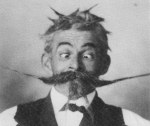The Moustache Movement

About 1855 the beard movement took hold of Englishmen. The Crimean War had much to do with it, as our soldiers were permitted to forego the use of the razor as the hair on the face protected them from the cold and attacks of neuralgia. About this period only one civilian of position in England had the hardihood to wear the moustache. He was Mr George Frederick Muntz, a member of Parliament for Birmingham. He was a notable figure in the House of Commons, and is described as manly in appearance, with a handsome face, a huge black beard, and moustache. He died 30th July, 1857, and is regarded as the father of the modern moustache movement.
Allan Peterkin more recently explored this nineteenth-century fashion in his history of facial hair titled One Thousand Beards
The comprehensive approach with which Peterkin addresses his slightly esoteric subject is remarkable, to the point of weirdness. Peterkin (shown lightly fuzzed in the author's photo) essentially assesses the entire history of the world through a beard's-eye view, addressing questions ranging from "What's the ritualistic symbolism of shaving?" to "What's the post-modern, post-feminist meaning of facial hair?"
Sounds like my kind of book!
I haven't shaved with a razor since I last held a nine-to-five job, which was in 2001. If all goes according to plan, I will never use a razor again in my life. I regard them as instruments of torture. Instead, I keep a permanent stubble by trimming my beard every few days with an electric shaver.
Comments
Commenting is not available in this channel entry.

Category: Fashion